GALLUP NEWS SERVICE
PRINCETON, NJ -- Even before the large stock market rally on Wednesday, Americans appeared largely hopeful about the stock market and about their own personal financial situations, according to the latest Gallup poll. In the short run, Americans are feeling a financial pinch and are more cautious than they have been in a decade about investing in the stock market. But by next year, most expect that the worst in the stock market will be over and that their own financial situations will be better as well.
The poll was conducted July 22-24, with about one-fifth of the interviews completed Wednesday evening, after the second-biggest point-gain in stock market history. However, the responses from interviews completed Wednesday evening appear consistent with those completed in the previous two days.
According to the overall results, just 32% of Americans say their financial situation is better today than a year ago, while 45% say it is worse -- the most negative ratio in the past 10 years.
| Financial Situation Now vs. Year Ago |
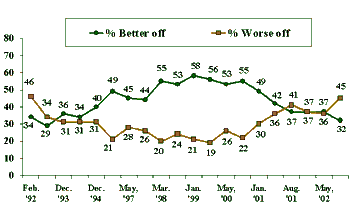 |
The last time that at least 45% of Americans said their financial situation was worse than the previous year occurred in February 1992, when President George H.W. Bush was beginning his unsuccessful bid for re-election. The most recent decline in positive feelings appears to have begun with the inauguration of the second Bush presidency, which economists see more as a coincidence than as a cause.
Despite this generally negative assessment of their current financial positions, Americans seem almost buoyant about the future. About two-thirds expect that they will be better off next year than they are this year, while only 14% expect to be worse off. These positive results reflect a generally optimistic mood of the American public. In the past quarter of a century, never have more people expected to be worse off than have expected to be better off in the coming year.
| Financial Situation Next Year vs. Now |
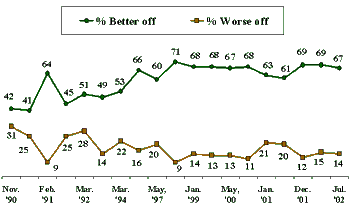 |
Still, as the preceding chart shows, the positive ratio has varied in size in the last 12 years. The worst reading was taken in November 1990, during the economic recession of the early 1990s, when 42% of Americans expected to be better off in the coming year, while 31% expected to be worse off. The most positive ratio was measured in March 1998: 71% expected better things in the coming year, and only 9% expected them to be worse.
Enthusiasm About Investing in Stock Market Tumbles
The poll shows that by a two-to-one margin, Americans think now is not a good time to invest in the stock market. These results are considerably more pessimistic than the views expressed in a Gallup poll last month.
| Good/Bad Idea to Invest in Stock Market? |
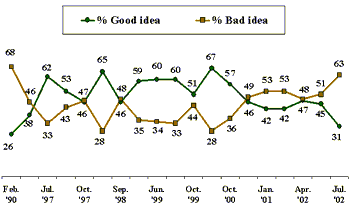 |
Even stockowners are dubious about investing in the stock market today. Just 40% say it is a good idea, while 54% say it is not.
During the stock market boom in 1999 and 2000, clear majorities of Americans thought it a good idea to invest in the stock market. But as the market declined in 2001 and 2002, the public became more ambivalent. Now, it has turned decisively pessimistic.
Still, Americans do not appear unduly worried. Just 18% say the recent decline represents a "crisis," while half say the decline is a "major problem," and 25% say it is at worst a minor problem. Those who own stocks and those who do not own stocks show little difference in their responses to this question.
| Public Characterization of the Stock Market Decline |
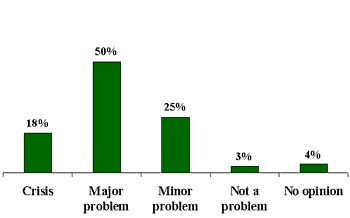 |
| July 22-24, 2002 |
The poll shows that the vast majority of Americans believe the bottom of the stock market's decline has not yet been reached. Just 17% think it has. (Those who were interviewed on Wednesday evening, after the near-record rally, show essentially no difference in their views from those interviewed in the previous two days.) But overall, a slight majority, 52%, expects that the bottom will have been reached within six months, and 66% say within a year. Seventeen percent of Americans expect the decline to take more than a year to bottom out, while another 17% are unwilling to hazard a guess.
| When Will Bottom of Stock Market Be Reached? |
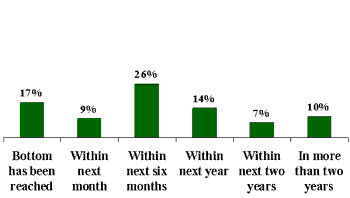 |
| July 22-24, 2002 |
Stockowners are considerably more optimistic than people who do not own stocks. Twenty-one percent of stockowners say the bottom has already been reached, while another 43% say it will be reached within the next six months. Overall, 64% of stockowners expect the bottom to be reached within six months, and 76% say within a year. Just 11% say it will take more than a year.
Public Mood Remains Stable
Despite the volatility of the stock market this past month, as the Dow dropped through the 8,000 level, the general mood of Americans has remained steady. The current poll shows that 49% of Americans are satisfied with the way things are going in the country, while 47% are dissatisfied -- virtually the same figures obtained last month. These figures are among the lowest obtained during the Bush presidency. The lowest point occurred in early September of last year, right before the terrorist attacks, when only 43% said they were satisfied and 55% dissatisfied. Following the attacks, Americans rallied around the flag and by December, in the aftermath of successful military efforts in Afghanistan, they were expressing the highest level of satisfaction recorded by Gallup in three years.
| Satisfaction in America: 2001-2002 |
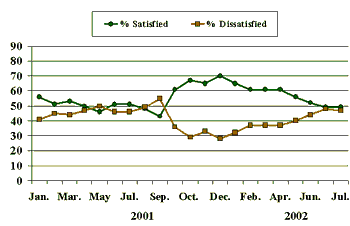 |
The current mood is much more positive, however, than it was from 1992 through 1996, when considerably more people were dissatisfied than satisfied. Despite the greater dissatisfaction, President Clinton was re-elected that year by a near-landslide proportion.
| Satisfaction in America: Yearly Averages 1979-2002 |
 |
Survey Methods
The results reported here are based on telephone interviews with a randomly selected national sample of 1,005 adults, 18 years and older, conducted July 22-24, 2002. For results based on this sample, one can say with 95 percent confidence that the maximum error attributable to sampling and other random effects is plus or minus 3 percentage points. In addition to sampling error, question wording and practical difficulties in conducting surveys can introduce error or bias into the findings of public opinion polls.

